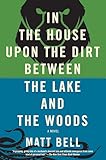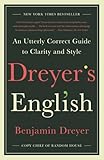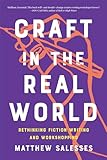Matt Bell’s new craft book, Refuse to Be Done, came into my life when I was struggling to revise a late draft of a novel. Bell’s book, which provides an overview of the novel-writing process, is useful at pretty much any stage of writing and revision, but I found it especially helpful for the final stages of revision, when you know a book so well that it is very difficult to see it with fresh eyes. Using some of Bell’s exercises, I managed to cut 20 pages from my most recent draft, even as I added two new scenes. What I appreciated about Bell’s tips for the final stages is that they are practical and actionable. In the early and middle stages, the best advice might be to take a walk and hope your subconscious picks up the slack, whereas at the end phases, you can experiment with removing section breaks, deleting chapter openings, and cutting filler words and phrases like “there is,” “there were,” “she thought,” “he saw,” etc.
I’ve
started with the end of the Bell’s book because in some ways it’s the heart of
his craft book and what makes it unique from other guides. Using Bell’s book,
you can successfully take your book from the earliest, roughest draft to a final,
polished edit that you could submit to an agent or publisher. Bell divides his
writing process into three drafting stages. The first stage is generative and exploratory
and involves writing a lot of material that might not make into the final
draft. The second stage is about identifying the story in the first draft and
giving it a robust structure, and the third stage is about refining the
language at the sentence level. The stages he outlines are similar to what I’ve
hit upon over the years and will likely be familiar to writers in many genres,
but they are described in a very clear, approachable way. I wish I’d had this
book when I first trying my hand at fiction.

 Bell’s novels include 2021’s Appleseed, Scrapper, and In the House Upon the Dirt Between the Lake and the Woods. Refuse to Be Done is his ninth book and comes directly from his experience as a novelist, as well as a teacher of creative writing at Arizona State University. Bell described the book to me as an approximation of his teaching persona: conversational, encouraging, and focused on helping the reader or student to write the best book they can. There is an enthusiasm at the core of Bell’s guidebook that makes it especially accessible, much like his monthly newsletter, the straight-forwardly titled “Writing Exercises from Matt Bell,” which provides writing prompts and often includes examples from contemporary fiction.
Bell’s novels include 2021’s Appleseed, Scrapper, and In the House Upon the Dirt Between the Lake and the Woods. Refuse to Be Done is his ninth book and comes directly from his experience as a novelist, as well as a teacher of creative writing at Arizona State University. Bell described the book to me as an approximation of his teaching persona: conversational, encouraging, and focused on helping the reader or student to write the best book they can. There is an enthusiasm at the core of Bell’s guidebook that makes it especially accessible, much like his monthly newsletter, the straight-forwardly titled “Writing Exercises from Matt Bell,” which provides writing prompts and often includes examples from contemporary fiction.
I
emailed with Bell about his book a few weeks ago; our exchange is edited for
clarity and continuity.
The
Millions: In your book, you divide the
novel writing process into three stages of drafting. Of these stages, is there
one that you prefer? Has it changed over the years or with different
projects?
Matt Bell: They all have their pleasures, but I think the second draft is often the one that feels most like what I imagined novel writing to be, before I did it: I’m working from an outline, usually writing more or less linearly through the story, and making the scenes the best they can be before going on. (I couldn’t do this without the exploratory, generative first draft, though, or at least haven’t so far.) I usually know my characters pretty well by then, and the voice of the book is pretty established. It’s the end of this draft that, book after book, feels most like a real accomplishment: at the end of the first draft, I just feel daunted by how much is left to do, where at the end of the second, I feel like I’ve written a novel.
As for what’s changed over the years? Every novel presents its own challenges—it’s absolutely true that the stubborn new novel does not care and is not impressed that you successfully finished the last one—but a lot of skills transfer over. For instance, I’m better at recognizing the various discouragements that always occur at certain stages, and I remember how I’ve pushed through or persevered in the past. I don’t know how much time knowing what to expect saves, but it does short-circuit some of the anxious handwringing.
TM: This brings up a question I’ve been thinking about: what is the
relationship between revision and time management? I notice I sometimes bring
an expectation of efficiency to revision that I don’t bring to a first draft,
and I’m not sure it’s particularly helpful, psychologically.
MB: I love this question, and I’d agree: focusing on
efficiency probably isn’t the most helpful approach with anything in writing,
or at least creative writing, which is so rarely on a real deadline. In
general, I’m trying to expunge all the productivity talk I can from my language
about writing, although I know I don’t always succeed. But I’m not a factory,
and I don’t want to treat myself like one either.
That
said, I do think the layered approach to revision I suggest in the third draft
part of the book is efficient, because it gives you a concrete series of
steps to take, instead of the nebulous “just keep making it better until it’s
finished” vibe that so much of my own education took. As I go through that part
of the process, I can feel the book moving closer to done every single day: it’s
actually one of the places where progress seems most apparent, at least for me.
TM: One important caveat you include is that writers might
need to go back and forth between these stages, and I wondered how often you
find yourself doing that? Has there been a moment in any of your books when, in
the final stages of refining sentences, you suddenly realize you need to write
a new scene?
MB: Yes! I can remember specifically the last scenes I wrote in both In the House Upon the Dirt Between the Lake and the Woods and Scrapper. The first was written in the final stages of working with my editor Mark Doten, where he highlighted a couple sentences of exposition and said they needed to be a scene: I thought it would be difficult to write it, so far from the drafting phase of the book, but it was one of the easiest scenes to write. The last scene in Scrapper was written after my last research trip to Detroit, conducted after I’d already drafted and revised the book. There was a film adaption of that book in the works that unfortunately came apart during Covid, but the screenwriter started his screenplay from that last-written scene. He told me, “That scene thematically contains the whole novel,” and I thought, Of course it does. It’s the only scene I wrote with the full knowledge of what the novel is.
I’ve
thought about that conversation a lot. There’s another world in which I started
over again from that scene and wrote a whole other draft—and who knows how much
farther that one might’ve gone? (Thank god the book was already published when
the screenwriter told me so I didnt try to find out!)
TM: Since this book comes out of your teaching, could you
describe what your students’ approach to revision tends to be when they first
come to you? What are the common pitfalls and mistakes that you see them
making?
MB: I think the biggest pitfall tends to simply be an unwillingness to radically revise, which in most cases means rewriting. Especially when you’re starting out, it costs you so much to make the first draft of something that the idea of doing it again is understandably abhorrent: certainly most students would rather write something else than write the same story again, or even a single scene of it. But I think if you can convince students to give it a try, the results are so good that they’ll eventually be convinced to make it part of their process. I’ve got a couple thesis students right now who are committed radical revisers, and it is amazing how much stronger a novel chapter gets with repeated attempts. I’ve seen one student compress 100 pages of action and backstory into a lean 20 over the course of a few attempts, and the sheer thrill we shared going over their latest draft was well-earned.
TM: How do you advise your students to incorporate feedback
into their revision process? You don’t give a lot of specific advice in your
book, only to keep the draft to yourself as long as possible. When do you
incorporate feedback from others? Does it depend on the project?
MB: I don’t usually share my novel drafts at all until they’re at the very end of the process outlined in Refuse to Be Done. Even after 10 years of working with my agent, I don’t tell him what I’m writing until I have at least a first draft down, and I don’t show him anything until I feel like I’ve gone as far as I can on my own. I’m probably a little more secretive than the average writer! But that also means that I am hungry for feedback by the time it comes.
I’ve been lucky to have talented, perceptive editors for my books, good at both plot/structure and at making my sentences shine. There’s always a period of learning to work with an editor (and their learning to work with you), but I’m game to try out just about any suggestion. More and more, I take sentence level suggestions without hesitation: on one draft of Appleseed, I hit “Accept All” without even reviewing the changes, then kept my eye out for anywhere something felt off to me as I reread and worked on other feedback. I tell this to friends, and they reliably gasp in horror, but it saved so much time and anxiety, and in the end there were only a few places where I had to “fix” something that had been done to my sentences. If you have a talented editor you can trust, you might try to do so: a good editor isn’t try to take your style from you, only make it the best version of itself. And, of course, then you’re doing your final edits on top of that help, instead of spending time resisting it.
The other best kind of feedback is actually the place where
an editor or a friend’s attention lights something up in the book for you. For
instance, there’s a thread in Appleseed drawing on the Tree of the
Knowledge of Good and Evil in Genesis that was there in my submitted draft but
wasn’t as developed as other parts of the book. My editor’s interest in that
renewed my interest in it, and the final version is better simply
because she was so into it. I think chasing a good reader’s enthusiasms about
your draft is a great way to find a door into the next rewrite.
TM: Okay, I admit I gasped at the idea of just hitting “Accept All,” though I can see how that’s a useful strategy in the final stages of revising. Do you think there is any danger of over-revising in the final stages?


 MB: I mean, that “Accept All” thing probably is lunacy, but a little wildness late in the process feels good too! It opens me up rather than shuts me down. I think there is likely danger in over-revising, and I think you see it especially in places like the openings of novels: they’re almost always screwed down a bit too tight. (Including mine, for sure.) There’s so much pressure on those pages, and we spend so much time with them, and in the end we do some damage in our attempt at perfection or acceptability or even just hooking the reader. I always think of Zadie Smith taking about rewriting the first 20 pages of On Beauty over and over: “I can hardly stand to look at my novels in general,” she said, “but the first 20 pages of each in particular give me heart palpitations. It’s like taking a tour of a cell in which I was once incarcerated.”
MB: I mean, that “Accept All” thing probably is lunacy, but a little wildness late in the process feels good too! It opens me up rather than shuts me down. I think there is likely danger in over-revising, and I think you see it especially in places like the openings of novels: they’re almost always screwed down a bit too tight. (Including mine, for sure.) There’s so much pressure on those pages, and we spend so much time with them, and in the end we do some damage in our attempt at perfection or acceptability or even just hooking the reader. I always think of Zadie Smith taking about rewriting the first 20 pages of On Beauty over and over: “I can hardly stand to look at my novels in general,” she said, “but the first 20 pages of each in particular give me heart palpitations. It’s like taking a tour of a cell in which I was once incarcerated.”
TM: How do you see research fitting into the revision
process? I get the impression from your book that it’s something to fit in as
needed but I wondered if you ever take a more structured approach?


 MB: I think there are a couple of kinds of revision-related research, for me. One is simply the going through the book and making sure you’ve got your facts right: in Appleseed, for instance, I wanted to make sure the science in my science fiction was more or less plausible, and in some places I needed it to be as airtight as I could make it. (Not much point writing about climate change if you get the climate science wrong.) But there’s also a real joy—maybe especially in that second draft phase—of doing research with the plot already in hand: by then, you know what your book is interested in, which means certain details catch your attention that would’ve gone right by if you’d researched before you started. That’s one of the stages of research that actually feels most enjoyable to me: where the novel is acting as a filter, letting through only what pertains in the material you’re sifting through.
MB: I think there are a couple of kinds of revision-related research, for me. One is simply the going through the book and making sure you’ve got your facts right: in Appleseed, for instance, I wanted to make sure the science in my science fiction was more or less plausible, and in some places I needed it to be as airtight as I could make it. (Not much point writing about climate change if you get the climate science wrong.) But there’s also a real joy—maybe especially in that second draft phase—of doing research with the plot already in hand: by then, you know what your book is interested in, which means certain details catch your attention that would’ve gone right by if you’d researched before you started. That’s one of the stages of research that actually feels most enjoyable to me: where the novel is acting as a filter, letting through only what pertains in the material you’re sifting through.
TM: What craft books do you rely on? Did you look to
any writing manual as a guide for this one?


 MB: Benjamin Dreyer’s Dreyer’s English came out around the time I was drafting this book, and I know it was a model of how to organize the material and how to stay in a conversational and encouraging voice. I really love the two Writer’s Notebook collections of lectures that Tin House put out, as well as Graywolf’s Art Of series. I just picked up Peter Ho Davies’s new The Art Of Revision from them, because apparently I’m not done learning about my own subject either! I think Matthew Salesses’s Craft in the Real World and Paisley Rekdal’s Appropriate are two essential reads for anyone writing today. Virginia Tufte’s Artful Sentences: Syntax as Style gave me the language to talk about sentence structure that I always wanted and didn’t have. Lately I’ve been obsessed with Samuel Delany’s About Writing and Charles Johnson’s The Way of the Writer, both of which are made of short, punchy essays full of wisdom. And Jane Smiley’s 13 Ways of Looking at the Novel feels like an essential text for me: a lot of my way of thinking about what I want my life as a novelist to be was shaped by Smiley’s willingness to share how she’s lived hers.
MB: Benjamin Dreyer’s Dreyer’s English came out around the time I was drafting this book, and I know it was a model of how to organize the material and how to stay in a conversational and encouraging voice. I really love the two Writer’s Notebook collections of lectures that Tin House put out, as well as Graywolf’s Art Of series. I just picked up Peter Ho Davies’s new The Art Of Revision from them, because apparently I’m not done learning about my own subject either! I think Matthew Salesses’s Craft in the Real World and Paisley Rekdal’s Appropriate are two essential reads for anyone writing today. Virginia Tufte’s Artful Sentences: Syntax as Style gave me the language to talk about sentence structure that I always wanted and didn’t have. Lately I’ve been obsessed with Samuel Delany’s About Writing and Charles Johnson’s The Way of the Writer, both of which are made of short, punchy essays full of wisdom. And Jane Smiley’s 13 Ways of Looking at the Novel feels like an essential text for me: a lot of my way of thinking about what I want my life as a novelist to be was shaped by Smiley’s willingness to share how she’s lived hers.
The post Becoming a Radical Reviser: The Millions Interviews Matt Bell appeared first on The Millions.
Source : Becoming a Radical Reviser: The Millions Interviews Matt Bell









